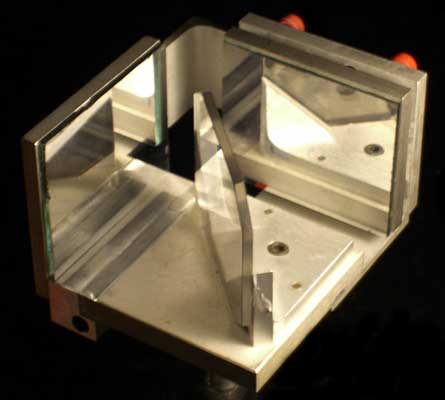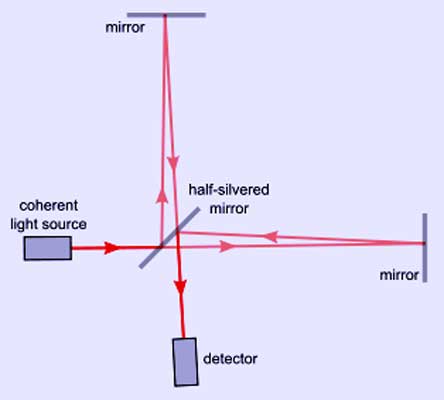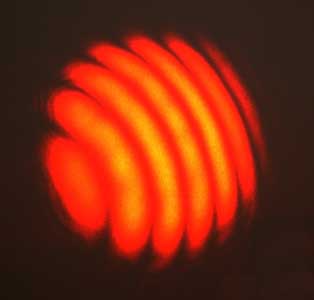.
Michelson interferometer
The Michelson interferometer is the most common configuration for optical interferometry and was invented by Albert Abraham Michelson. An interference pattern is produced by splitting a beam of light into two paths, bouncing the beams back and recombining them. The different paths may be of different lengths or be composed of different materials to create alternating interference fringes on a back detector. Michelson, along with Edward Morley, used this interferometer for the famous Michelson-Morley experiment in which this interferometer was used to prove the non-existence of the luminiferous aether.

A Michelson interferometer for use on an optical table (*).
Configuration
There are two paths from the (light) source to the detector. One reflects off the semi-transparent mirror, goes to the top mirror and then reflects back, goes through the semi-transparent mirror, to the detector. The other first goes through the semi-transparent mirror, to the mirror on the right, reflects back to the semi-transparent mirror, then reflects from the semi-transparent mirror into the detector.

Path of light in Michelson interferometer.
If these two paths differ by a whole number (including 0) of wavelengths, there is constructive interference and a strong signal at the detector. If they differ by a whole number and a half wavelengths (e.g., 0.5, 1.5, 2.5 ...) there is destructive interference and a weak signal. This might appear at first sight to violate conservation of energy. However energy is conserved, because there is a re-distribution of energy at the detector in which the energy at the destructive sites are re-distributed to the constructive sites. The effect of the interference is to alter the share of the reflected light which heads for the detector and the remainder which heads back in the direction of the source.
In the late 1800s, the interference pattern was obtained by using a gas discharge lamp, a filter, and a thin slot or pinhole. In one version of the Michelson-Morley experiment, the interferometer used starlight as the source of light. Starlight is temporally incoherent light, but since it is a point source of light it has spatial coherence and will produce an interference pattern.
Applications
The most well known application of the Michelson Interferometer is the Michelson-Morley experiment that provided evidence for special relativity. However, this configuration can be used for an assortment of different applications.
The Michelson Interferometer has been used for the detection of gravitational waves, as a tunable narrow band filter, and as the core of Fourier transform spectroscopy. There are also some interesting applications as a "nulling" instrument that is used for detecting planets around nearby stars. For most purposes, however, the geometry of the Mach-Zehnder interferometer is more useful.
A further application is to produce a delay line interferometer, i.e., an optical DPSK demodulator that converts phase modulation into amplitude modulation in DWDM networks.

Interference pattern of a HeNe-laser (633nm) at a Michelson Interferometer (*)
Nonlinear Michelson interferometer
Nonlinear Michelson interferometer, also known as Step-phase Michelson interferometer is a generalized Michelson interferometer in which one mirror in one arm is replaced with a Gires-Tournois interferometer or Gires-Tournois etalon. The field coming from Gires-Tournois etalon interferes with the plane field reflected from the ordinary reflector. Because the phase change from the Gires-Tournois etalon depends on wavelength and shows step-like behavior, nonlinear Michelson interferometer has particular applications. One notable application in fiber-optic communications is an optical interleaver.
The two mirrors in a Michelson interferometer can be replaced with two Gires-Tournois etalons. Such a nonlinear Michelson interferometer exhibits stronger nonlinearity, which can be used to construct an asymmetric optical interleaver.
References
* F. Gires, and P. Tournois (1964). "Interféromètre utilisable pour la compression d'impulsions lumineuses modulées en fréquence". C. R. Acad. Sci. Paris 258: 6112–6115. (An interferometer useful for pulse compression of a frequency modulated light pulse.)
See also
Links
Retrieved from "http://en.wikipedia.org/"
All text is available under the terms of the GNU Free Documentation License

